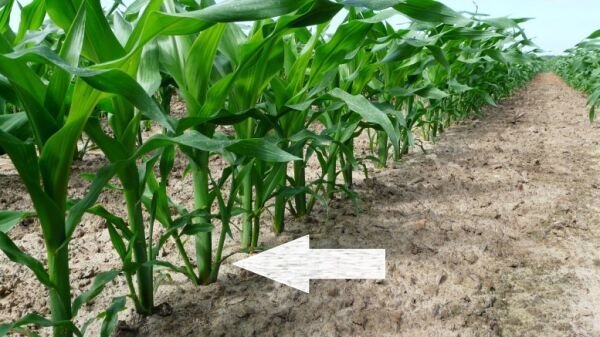Cause of tillers
Tillers are lateral branches that form at lower, below ground nodes. Further up on the corn plant, similar branches develop into ear shoots. Although tiller buds form at each below-ground node, the number of tillers that develop depends on the plant population and spacing, soil fertility, early season growing conditions, and the genetic makeup of the hybrid.
Corn plants of nearly all hybrids adjust to take advantage of available soil nutrients and moisture by forming one or more visible tillers where stands are thin, where there are skips in the row, or at the ends of rows.
Extensive tillering can also occur when the primary growing point is damaged or removed by hail, frost, or herbicides.
Tillering is most likely when soil fertility and moisture supplies are ample during the first few weeks of the growing season. Hybrids with a strong tillering trait may form one or more tillers on every plant, even at relatively high plant populations if the environment is favourable early in the growing season.
Do tillers drain the main plant?
More than 80 years ago, researchers evaluated the effects of corn tillers. They removed tillers from the main plant early in the season, then compared the yields of those plants with similar plants that had their tillers left on all season.
They found that tiller removal never increased yields and usually reduced yields.
This led to the recommendation at that time that farmers use their time for something more worthwhile than removing corn tillers. Tillers were known to have roots, but it was unclear whether the greater yields with tillers was due to the tillers feeding the main plant or because of the grain produced in tiller ears. Some agronomists said it was neither, but rather that the yield decrease was brought about because of the injury involved when the tiller was removed.
It was not until the 1930s that leaf removal studies were conducted to provide a better understanding of tiller/main plant relationships. In these studies, corn was grown at low plant populations so that large tillers would develop on many plants. Then all the leaves were removed from the main plant during early grain fill. Half of the defoliated main plants had tillers, the rest did not. The tiller leaves were left intact. Plants with tillers yielded nearly twice as much grain as did plants that had no tillers. It appeared that a connection existed between the tiller and the main plant that allowed food produced in tiller leaves to get to ears on the main plant.
More recent techniques allow for direct measurement of this movement. Carbon is an important component of both sugars and proteins needed for ear fill. The carbon in carbon dioxide can be labelled with radioactivity. When this labelled carbon dioxide is taken up by a leaf, it can be followed through the plant. Detection of this labelled carbon in other plant parts (such as an ear) later in the season indicates movement of the original labelled carbon from leaf to ear.
Plant physiologists at the University of Wisconsin using such labelling techniques found that little movement of food takes place between main plant and tillers before tasselling. Immediately after silking and during grain fill, though, substantial amounts of food moved from leaves of large, earless tillers to the ear on the main plant.
There was little food movement when ears were on both the tiller and the main plant. In other words, main plant ears received their food from main plant leaves, while tiller ears received their food from tiller leaves.
The only time when food moved from main plant to tiller was when there was an ear on the tiller, but none on the main plant. This, of course, is not a likely situation under most field conditions. (This work was done experimentally, where anything can be made to happen, when researchers are trying to learn how plants work.)
These studies were conducted at a low plant population – about half that would normally be found on soils of that level of fertility – to stimulate the formation of large, healthy tillers. The small, shaded tillers without ears that normally develop under a full stand in normal field conditions will probably have little influence on the main plant. If there is a slight influence on grain yield, it would most likely be in the positive direction.
The only time when tillers might hurt yields under normal conditions are if the weather becomes exceptionally dry after a favourable spring. Such a condition could give rise to extensive tillering and a great many leaves which might then provide too much transpiration and deplete water early in the season that would be needed later to completely fill out the kernels.
Under low plant populations, tillers may be large and numerous, but they will not deplete the main stalk of nutrients needed to fill the grain.
In fact, in low plant stand situations, tillers may actually contribute to increased grain yields by either feeding the main plant or by producing grain on their own ears.
Agronomic comments
If you have a great deal of tillering in your field, don’t automatically become concerned or blame the hybrid. First check your stand density and distribution. If you find within-row gaps or less than optimum population, it could be those conditions, rather than the hybrid itself, which is responsible for the tillering. You can be confident that those tillers will most likely have no appreciable influence on the grain yield from that field.
CN0623-06A

